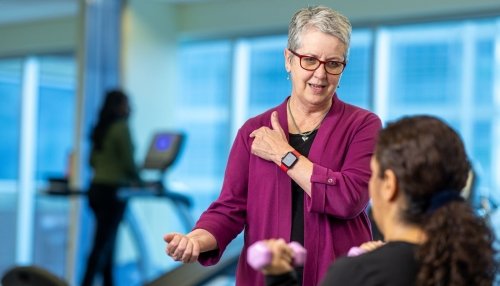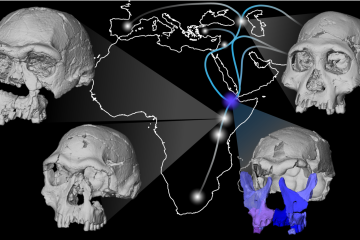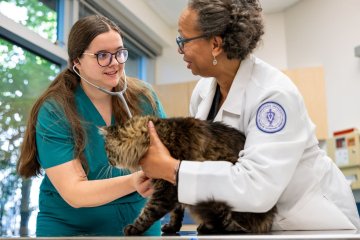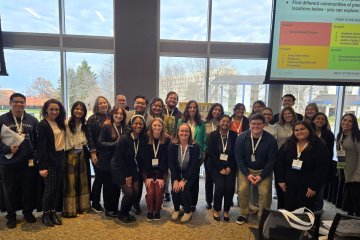Physical Therapy Institutes Assist Patients with Rotator Cuff Issues
Patients suffering from pain associated with rotator cuff tears can receive movement therapy and other treatment.
- AZ - Glendale
- IL - Downers Grove

Nearly two million people go to the doctor’s office yearly due to tears in their rotator cuffs (muscles and tendons around the shoulder’s joint), according to the American Academy of Orthopedic Surgeons. Through Midwestern University’s Physical Therapy (PT) Institute, patients suffering from pain associated with rotator cuff tears can receive movement therapy and other treatment for a range of issues with shoulder pain.
Mark Kargela, D.P.T., Clinical Assistant Professor at the PT Institute in Glendale, AZ, and Thomas Dillon, D.P.T., Clinical Assistant Professor at the PT Institute in Downers Grove, IL, spoke about exploring conservative care for rotator cuff issues and the advantages of movement therapy as a part of the virtual Community Health Lecture Series. Dr. Dillon went over the typical findings on imaging scans. “The presence of tear does not always equal dysfunction or pain or limitations. It may just be something that has been identified in an image and is not quite impactful, although many times it is,” Dr. Dillon said. Dr. Kargela added, “We always tell students we treat people, not their scans, because sometimes those scans are meaningful clinically and sometimes they’re not. But that’s why a nice thorough clinical evaluation will help us get some understanding of how relevant those images are.” Drs. Dillon and Kargela emphasized that sometimes patients have shoulder pain, but do not have a rotator cuff injury, while other patients do not experience pain and have tears appear on the scan. They also spoke about imaging and when it is most effective, such as after the patient experiences a trauma, like a fall, to determine the extent of the injury.
Dr. Dillon said the rotator cuff is often torn one of two ways, a degenerative tear or a traumatic tear, which occurs after an event such as an accident or a fall. Drs. Dillon and Kargela went over risk factors for degenerative rotator cuff tears, such as age, smoking, and poor posture. Dr. Kargela added a patient’s history of shoulder use, such as manual labor or athletics, and other daily activities involving their shoulder use can also contribute to shoulder pain. In addition, patients can experience these issues if they are sedentary during the week and conduct a task like heavy yard work during the weekend, Dr. Kargela said.
The doctors also emphasized movement therapy as the initial treatment. Dr. Kargela said, “Conservative care usually is your first stop. A lot of our orthopedic colleagues, who we have good relationships with, are going to send you to a PT (physical therapist) for six to eight weeks before they entertain surgery just because a lot of those folks will recover well.” Initial treatment begins with checking the range of motion, limitations, impairments, and signs of inflammatory components, followed by designing a program with passive manual therapy techniques to restore a range of motion, and eventually, a strengthening program specialized for the patient. Dr. Dillon added, “If you’re seeking treatment or about to get treatment, expect to have them (the physical therapist) put a lot of effort in the strengthening of your deltoid (shoulder), the rotator cuff muscles, the scapular muscles (shoulder blade).”
Dr. Kargela spoke about the misconception of not moving the injured area. “We can reinforce and strengthen the existing fibers and strengthen the areas. Exercise is very safe and one of the best things to start getting your shoulders less sensitive to loading, reaching, and lifting, through working slowly into exercises that strengthen your shoulder.” Dr. Dillon added past treatments initially began with rest, but evidence now shows the benefits of movement therapy. “If we get them up and moving after this surgery or this injury, they do better than if we make them lay in bed all day. The rotator cuff is no different. It's going to involve the joint, the muscles surrounding it, and we're going to be addressing all of this and the progressive loading of those muscles is going to be incredibly helpful.” Dr. Dillon also addressed the issue of pain. He said there is an appropriate degree of pain during treatment, and the patient should define if their symptoms are pain, soreness, or stretching during the course of treatment. Dr. Kargela chimed in, “I tend to tell folks a four out of 10 on the pain scale that goes away within 24 hours is usually a good rule of thumb to think about when it comes to soreness after exercise. We make sure to have those discussions with our patients. We don’t do anything that would threaten the integrity of the shoulder tissue, but it’s something important to be willing to nudge into that sensitivity is what’s going to help that sensitivity decrease more rapidly over time versus waiting for everything to feel perfect before we move forward.”
Surgery is a final option if treatment is not effective enough for the patient. Dr. Kargela discussed the recovery time from shoulder surgery. “It depends on how involved the surgery is. For instance, rotator cuff tear surgery can be wonderful. But, it is a difficult rehab. You're not able to use your arm actively very much for the first six to eight weeks, sometimes longer depending on how much repair work needs to be done. Generically, if it's a very minimal small tear that's not highly involved surgically, sometimes you'll hear a doctor say recovery time is three to four months and then maybe all the way to six to eight months if it's a more involved surgery.” Dr. Dillon added, “There are four rotator cuffs, and the unofficial bicep is your fifth rotator cuff muscle. This means that just because someone says they have rotator cuff surgery, you don't know if they had a simple, small, partial thing going on with one of those muscles, or if they had three tears. The muscles all do different things. You can imagine if someone has three rotator cuff muscles affected, they're going to have a longer recovery.”
In addition to treating patients with shoulder cuff issues, the Physical Therapy Institutes in Downers Grove or Glendale offer specialty programs to assist patients with a variety of pain management. Students interested in pursuing a career in physical therapy can learn more about the programs in Downers Grove or Glendale.



